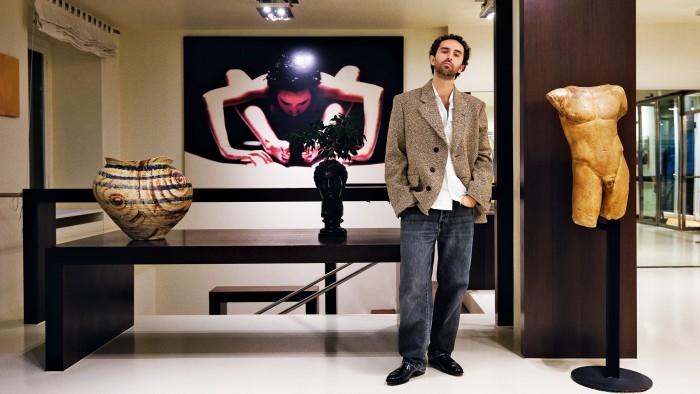In 1970, Carlo Tivioli founded his eponymous furriers, at the dawn of Italian Alta Moda. His unorthodox creations thrilled the transatlantic beau monde; furs that were dyed, shaved, and otherwise flouted design conventions were sent down the runway on models wearing jeans, or camisoles, or sometimes nothing but stilettos. Tivioli counted titled Europeans and film and music royalty among his collectors. His designs slipped off the shoulders of Claudia Schiffer, Naomi Campbell and Cindy Crawford in Vogue and Elle.
Clemente Tivioli, Carlo’s son, spent his childhood shuttling between Milan (where Tivioli’s Gae Aulenti-designed boutique sits on Via Santo Spirito) and Turin (where its laboratory is based), acquiring via osmosis a basic understanding of the company’s economics and manufacturing. He began collaborating at Tivioli in 2016, but he had briefly worked at Sotheby’s, and thought he might still go his own way at some point, to specialise in contemporary art. “[Working with my father] was never imposed on me,” Clemente, now 31, says. “If anything, there was always this sense that I would have had to earn it.”

As minimalism and quiet luxury gained purchase in fashion, and fur’s reputation was increasingly embattled in both the industry and the culture, Tivioli’s finances were faltering. When Carlo died suddenly in 2020, Clemente’s choice was made for him. Newly at the helm, he faced two daunting, seemingly opposed mandates: lead Tivioli out of the red and effect a total shift away from fur. “I had to have a product we could produce in our already existent atelier, with our already trained artisans” – some of whom had been with Tivioli for 40 years. “Those fils rouges of style and quality both had to be at the same level my father had established. But we had to find some new medium to express them.”


Shearling was a material Clemente had already been toying with conceptually. It is, relative to fur, sustainable: that same year, he had located a supplier who dealt only in pelts that come from the meat-industry supply chain. It’s scarce when of good quality, which lends it that same aura of exclusivity that rare furs had back in the Tivioli heyday. And it is endlessly workable, for someone blessed with the imagination to manipulate it and a team of technically fluent craftspeople to execute the designs. “My shearlings are treated artisanally, just like our furs were, which gives them that malleability,” he explains. Of the material’s reputation, he says “it allowed people sceptical about our business to either come back, if they were old- or long-time clients, or to discover it if they didn’t know us”.

What they discover are fantasy outer garments, each a one-off or one of a limited edition, whose palette runs the rainbow gamut and whose material embellishments come from Morocco, western Africa, India, Myanmar, Japan and beyond. Shearlings are dyed azure, carnelian, jade or teal green, hot pink or navy, or left natural in shades of cream, buckskin or deep brown. The passementerie, ribbons and fabric remnants impart extra – sometimes really extra – drama and colour. A short navy suede jacket with a mandarin collar (£5,500) has horizontal stripes intricately cut out of its bodice, each one matched with vintage Italian Ajour trimmings. A simple kimono-cut coat (£9,300) is bordered at its neck, sleeves and hem with strips of an Indian ceremonial cloth; a shorter version, dyed a delicate mint-green, features antique Japanese raw silks (£7,400).


Buttons are glass or metal – sourced, like the fabrics, by Clemente on his travels (the prevailing “moment” in the shop this autumn is Japanese-inflected, with shibori-dyed and woven silks and hand-tooled brass buttons in abundance). For the minimalists, upstairs in the two-level store is a judicious selection of simple, single-button blazers and belted trenches in deliciously pliant leather and suede (from £2,500). Each is finished as meticulously on the inside as it is outside.
“My real luck was to inherit a company founded by a man of the generation that could have been my grandfather’s,” Clemente – serious, considered, older-seeming than his 31 years – says of his father, who was in his late 50s when Clemente was born. “If there had been a generation between us, those values would have been corrupted by mass production and manufacturing. But the whole value system we have is still that of the 1970s.”


He’s lucky too in that working outside of fashion’s relentless calendar has dovetailed with the brand’s new ethos of slow production. Today Tivioli makes only 500 pieces a year, throughout the year. “So much money and effort was invested into one event,” he says of participating in the shows, “and even then the effect remained quite local – the Milano-sphere, the Italia-sphere. My objective was to maintain the same level of quality and control”, but also create more global awareness. “It so happens that it has augmented the desirability of the product.”
Beyond the Milan boutique, and a few pieces that can be found at Gorsuch in Aspen, Tivioli sells via trunk shows in Gstaad, Monaco, London, Geneva, Rome and Paris. They align with the kind of brand he wants Tivioli to be; he doesn’t advertise or have ecommerce or wholesale vending platforms. “It’s all word-of-mouth, and nurturing and working with clients, learning that certain clients like certain things.”
He says these clients recognise that “it says something about them, too” when they wear Tivioli. “You’re not just buying a coat; you’re buying a story. And the product has to guarantee that story, by reflecting all these notions – of family, hands, craft, deep research, heritage.
“But then you’re also involved in telling it,” he adds, “and the thing I see again and again is that once you’re part of our story, you end up really falling in love with it.” He smiles, possibly aware that he could as easily be talking about himself.
Via Santo Spirito 24, 20121 Milan; tivioli.it

